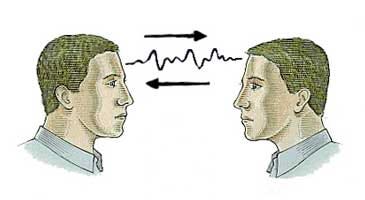Brain-synching: What Happens When You Converse with Other People

Over-used expressions like “on the same page” or “same wavelength” may actually have some physiological truth behind them. When two people are having a conversation or listening to the same story, it makes sense that they’d be using similar parts of their brain, but the question is just how similar this activation is. Drexel and Princeton Universities teamed up recently to further explore this issue using a newer technology, hoping to prove its efficacy.
Using functional near-infrared spectroscopy (fNIRS), a functional brain imaging technique, researchers sought to find out what happens when two people communicate and how to possibly improve face to face communication. In this study, experimental subjects wore an fNIRS headband which measured their neural activity while they engaged in conversation with one another. This in itself is pretty great as other imaging techniques like fMRI that measure blood flow to brain regions require people to lie down in a noisy machine, which is not at all conducive to personal conversation.
During the experiment, subjects listened to a story in their native language while their futuristic headbands measured activity in prefrontal and parietal areas. These regions were targeted because they’re largely responsible for higher order processing involved with relating to others, an important piece of any communicative effort. When they examined the recordings, the researchers saw that brain activity of the listener heavily resembled that of the speaker after a delay. This copy-cat effect, however, was not observed when subjects didn’t understand the communicator, for example when the speaker only communicated in Turkish but the listener was only fluent in English.
With the results from fNIRS, the experimenters found that the fNIRS recordings correlated quite closely with fMRI results of a similar experiment. This is a pretty big deal since it confirms that fNIRS is a legitimate functional imaging technique that could open the door to a brand new wave of experiments involving communication. fNIRS will prove a useful tool in the future, especially to decode the issue of “brain-synching” during conversation.
~ Jackie Rocheleau
Sources:
Measuring speaker-listener neural coupling with functioning near infrared spectroscopy
Brain imaging headband measures how our minds align when we communicate
Image Source:
https://cdn-images-1.medium.com/max/800/0*BZrVsheqbGZyc954.jpeg